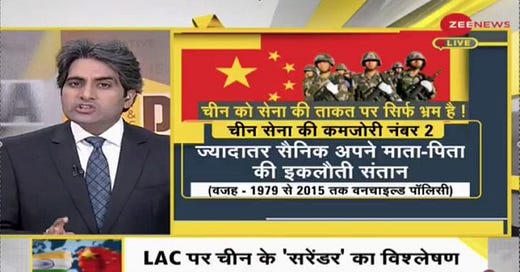9 by 9: What does BHAKT stand for?
And why you should trust data from a PhD in environmental toxicology at Cornell
1 by 9: Democratic dividend
If you go by the sarkari narrative, the conflagration at the border between India and China at Ladakh is cooling; both sides have retreated a bit; and there will be more meetings to defuse the situation in the next 10 days.
But as Business Standard writer Ajai Shukla notes, these claims (which he uses himself in his report) are not official “on-the-record” statements—they are “source-based” and deniable. His tweet—“People on the ground say there is no pullback”—suggests the opposite of the official word.

But the temple bells are clanging triumphantly in the alternate universe of bhakt media, and Sudhir Chaudhary of Zee News hits the sweet spot.
Thanks to Soothing Trance, we now know why Chaudhary thinks China may be stepping back: because the Chinese Army is weaker than the Indian Army; because its soldiers are namby-pamby, sentimental, depressive products of the single-child policy.



It sounded so sweet till another analyst Praveen Swami pooped the party. He says there’s serious scholarship that makes the same case as Sudhir Chaudhary’s and points to a 2014 article in the South China Morning Post.
Professor Liu Mingfu from the People’s Liberation Army’s National Defence University says at least 70 per cent of PLA soldiers were from one-child families, and the figure rises to 80 per cent among combat troops.
The impact of the one-child policy on China’s long-term security has apparently been discussed since 1993, and historically sending a Chinese family’s only son to battle had been taboo since ancient times.
China partially relaxed its strict curbs on a second child in 2013, but the impact of that can only be felt 20 years from now. Which means till then, what Sudhir Chaudhary says to his critics will be right.
Maybe this is why RSS wants Hindus to have more children. Then again, where’s the need when Mohan Bhagwat says RSS could have an Army ready in three days.
“Preparing an army takes six to seven months but we [RSS cadres] will be battle ready in two-three days...this is our capability and discipline that marks us apart.”
2 by 9: ‘Rotten Apple’ of Corona
Just before Moody’s downgraded India’s credit ratings to a notch above junk, BJP MP from Jharkhand Nishikant Dubey said this was all happening at the behest of China and urged the Prime Minister to take action against such agencies.
Pretty soon, it looks like the stage will be ready for similar demands against Universities, think tanks and researchers producing numbers (and conclusions) that do not match with the ones produced by the data decorators at Niti Aayog.
Reason: Johns Hopkins’ University’s applied economist Prof Steve Hanke includes India among countries that “either do not report #COVID data or are reporting highly suspicious data”.

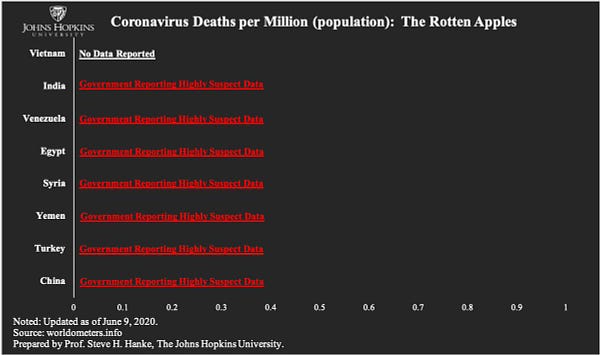
India’s Corona numbers have been mind-bending from the very beginning, when BBC quoted doctors as saying so; when Reuters reported 67% fewer deaths in March 2020 compared to March 2019 in Ahmedabad; and when German researchers said India had 136,000 victims when its official score was a measly 18,000.
One way of avoiding bad news is to convince yourself it doesn’t exist.

Anyway, let the record show that the for four days running, the number of new cases has been 9971, 9983, 9987 and 9985, all miraculously short of 10,000.
The Narendra Modi government’s allergy for inconvenient data is an old failing. It was hummed home in this fine song by Aisi Taisi Democracy, sung here by Rahul Ram, a PhD in environmental toxicology from Cornell.
3 by 9: Mock a killing bird
How does the end of a grassland and wetland habitat look like?
On Facebook, Snighdha Mukhopadhyay records for posterity the blaze sparked by a gas leak that brought down Maguri Bheel near Tinsukia Town, in Assam.
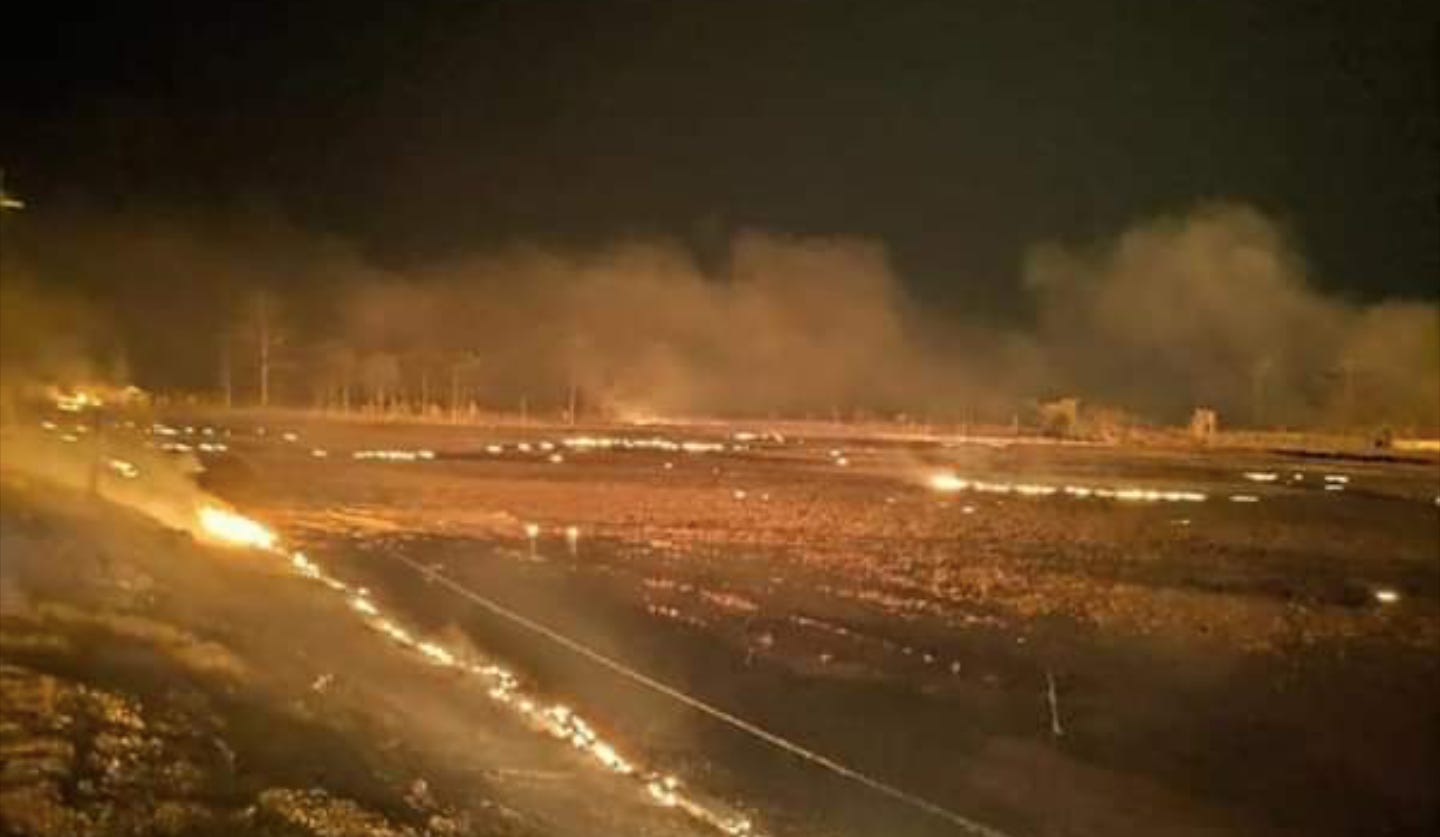
“Every bird in the vicinity has disappeared. The ministry of environment, forests & climate change' recently gave permission to dig two more oil wells in the national park,” she writes.
4 by 9: Perverse swing, by Sachin
West Indian cricketer Darren Sammy’s accusation of racism in the Indian Premier League has revived memories of “Monkeygate” on India’s 2008 tour of Australia.
Sammy says he thought being called “Kaallu” meant strong stallion.

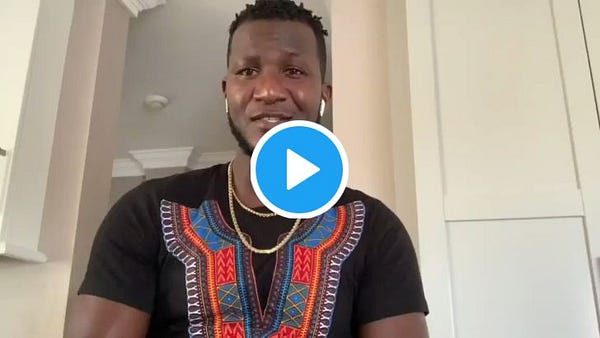
Lawyer Sarayu Pani has put “Monkeygate” scandal in context in a thread.
“On January 4, 2008, on an acrimonious day of play, during a gritty 8th wicket partnership between Harbhajan Singh and Sachin Tendulkar, words were exchanged between Andrew Symonds and Harbhajan. Harbhajan allegedly taunted Symonds with the word “monkey”.
“In the initial hearing, match referee Mike Proctor (himself an apartheid era South African player) found Harbhajan guilty of racism related offences. In his 2018 book, Proctor revealed that Sachin offered no evidence (either positive or negative) in relation to what was said at that hearing.
“During the hearing, Harbhajan said he had no knowledge of the English language and then manager Chetan Chauhan argued that it was “impossible” for Indians to be racist. Harbhajan was banned for three Test matches and the insanity began.
“Harbhajan appealed the decision, which was his right under the ICC Code of Conduct and India threatened to walk out of the tour. In the appeals hearing on January 29, Sachin, for the first time offered his “Maa ki” counter explanation, which led to Justice John Hansen dismissing the racism charge for lack of evidence.
“The entire national reaction at the time was to treat the charges not as an alleged racist event to be investigated but a huge insult to our national integrity. It became so important to “win” that Sachin was rolled out to use his international credibility to secure it. It still makes no sense as to why Sachin (if he did hear what happened across 22 yards) didn’t speak out at the initial hearing.
“We may have “won” the appeals hearing, but we lost an opportunity. An opportunity to teach young Indian cricket fans that racism was not ok. Instead we taught them that it was amusing to be racist, make up a cover story and get away with it. And their hero, Sachin, was complicit.”

5 by 9: Social is the new mainstream
Big media trying to protect its cross-media ownership may bark all it wants at social media (or at players who do not want to do business with it) but its ability to reach parts traditional media can’t/don’t is there for all to see.
On his Instagram account, Brazilian writer and lyricist Paul Coelho’s posted a simple picture of a book shop in Kerala shot through a car window.

Such is the power and reach of direct communication that the Bangalore-based newspaper Deccan Herald has a full report on it.
6 by 9: Onion, here we come (or go)
The first two issues of the BHAKT magazine are out from the media empire of game designer Anand Ramachandran.
‘BHAKT’, as in Being Hindu And Knowing Things
‘BHAKT’, as in BJP Hates All Knowledgeable Things
“With mainstream print media so biased and hell-bent on spreading lies and misinformation, here’s a magazine the nation truly needs in these difficult times.
The inaugural issue features Narendra Modi: “Crap Who have I done?” PM Modi opens up on his 10-point plan to melodramatically apologise on TV for screwing up civil society and the economy.
The second issue features, naturally, No. 2: “Arogya Setu sucks because Jawaharlal Nehru wrote bad code”—Amit Shah explains why former PM’s lack of full-stack development skills is responsible for shitty COVID app.
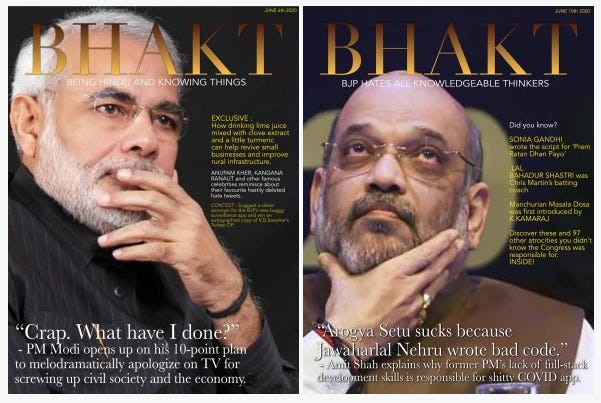
Admire Anand Ramachandran’s covers more closely here: Issue #1, Issue #2
7 by 9: The last lap
What is it like to perish in a pandemic without the tears of your near and dear ones on your dead forehead? On Instagram, Parul Sharma has four great pictures of the lonely last journey sans rites, from the Nigambodh electric crematorium, in Delhi.
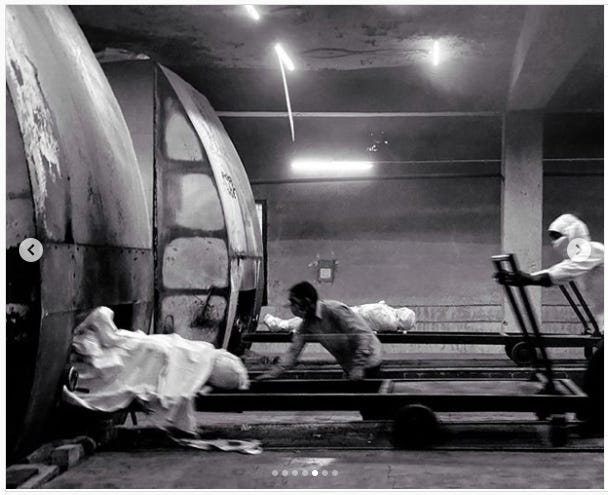
8 by 9: Boot and the other foot
Look who wants you to sign a petition to urge Hindustan Unilever to discontinue Fair & Lovely. Movie star Richa Gangopadhyay, an MBA, now nestled in Oregon.
And, finally
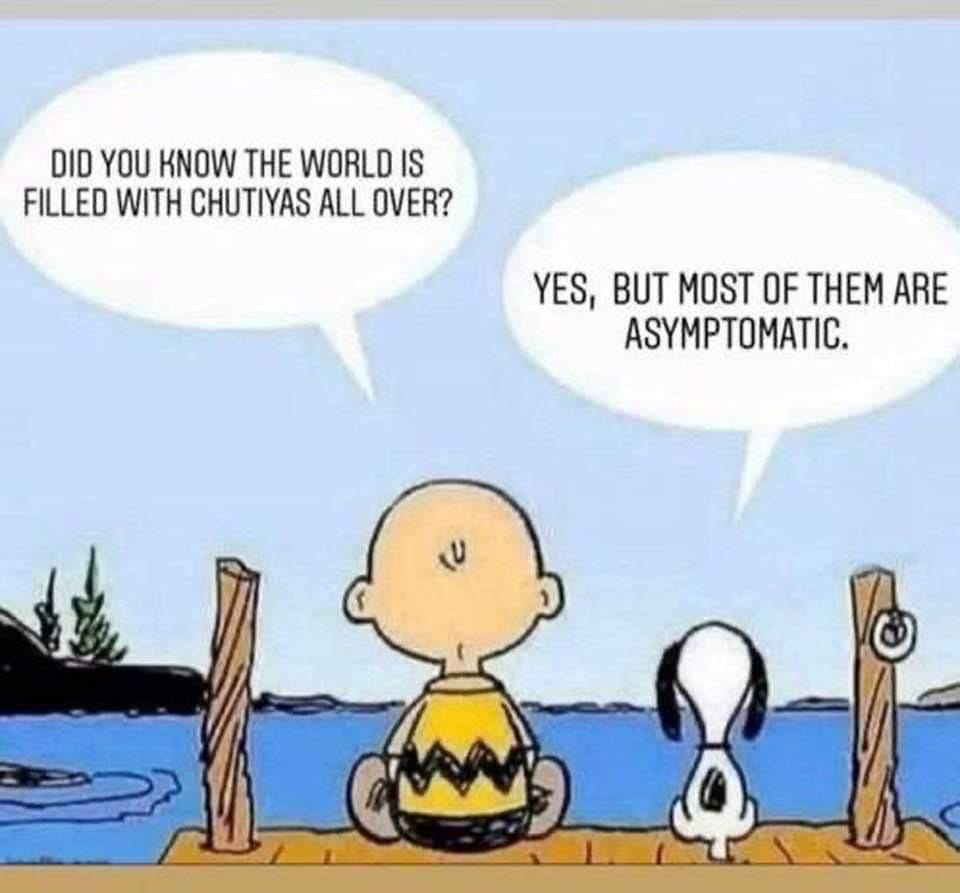
Like what you see? Show us some love. Don’t? Tell us why. Have a tip? Mail us.
Spread the word about The Net Paper, the world’s first social media newspaper.

